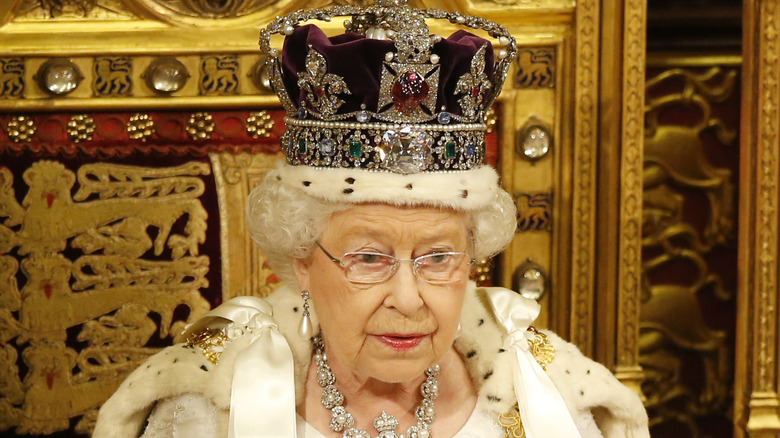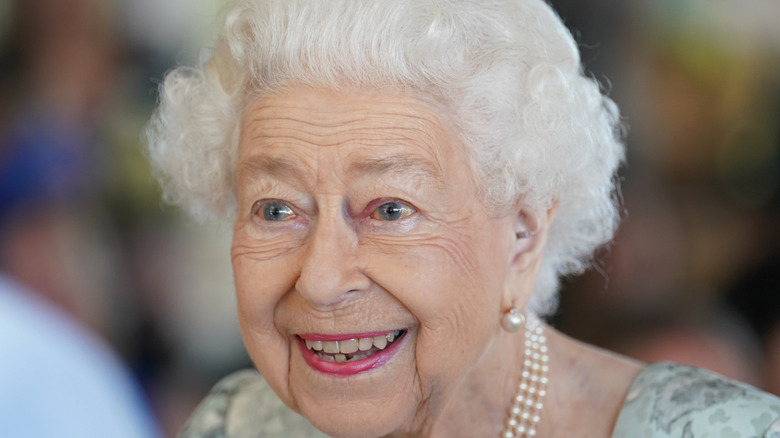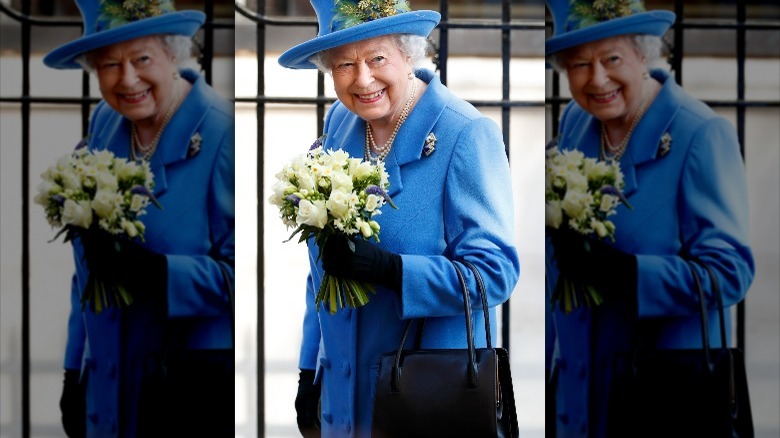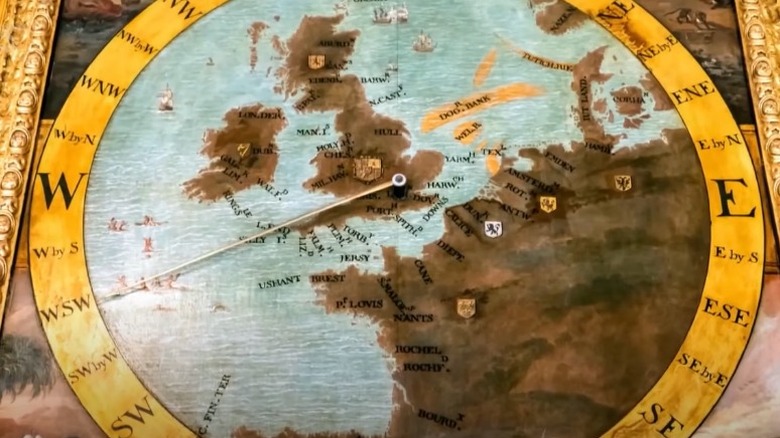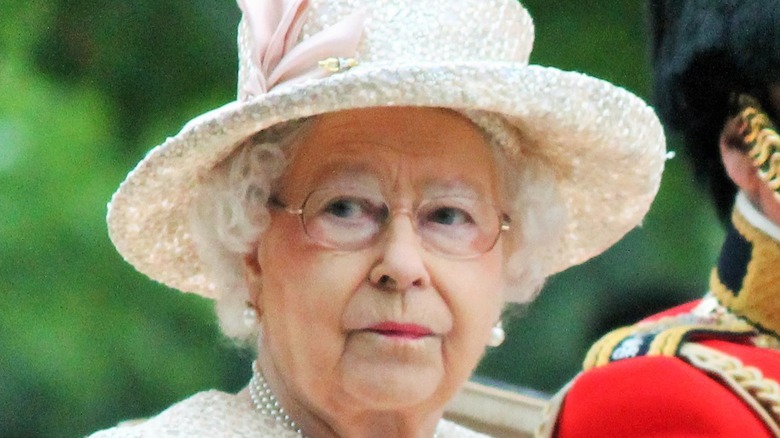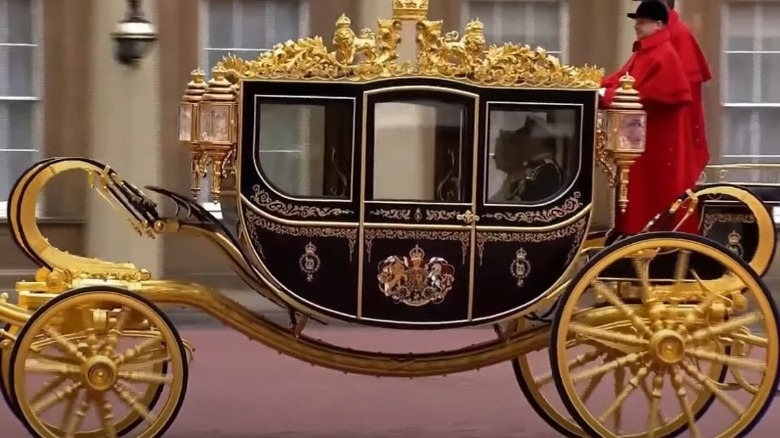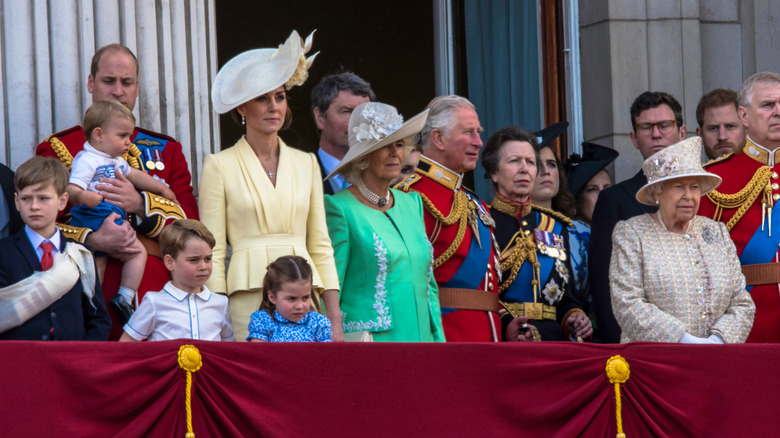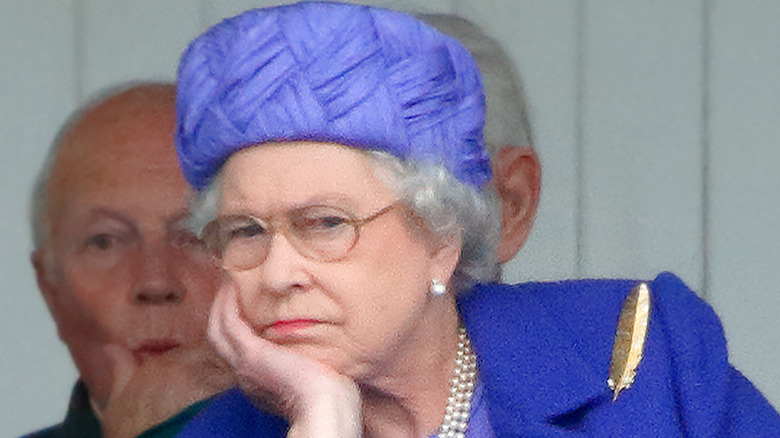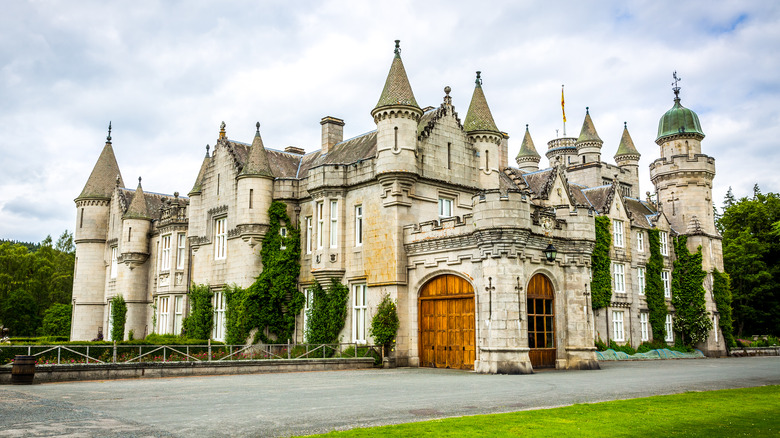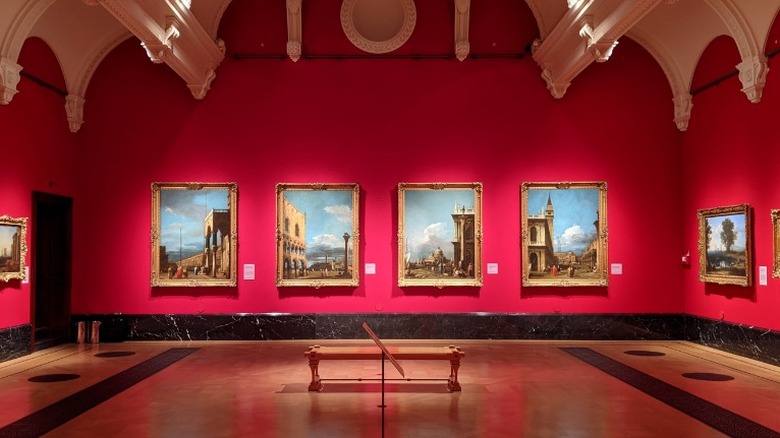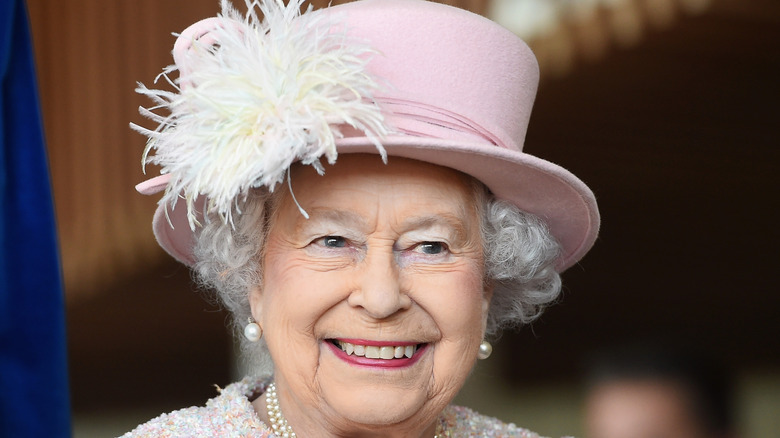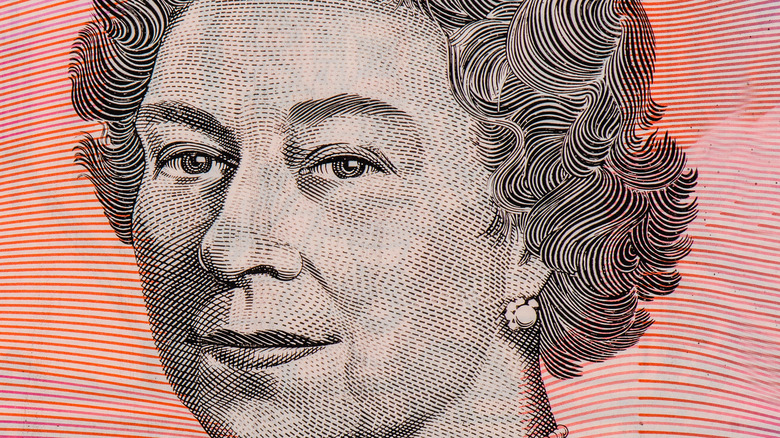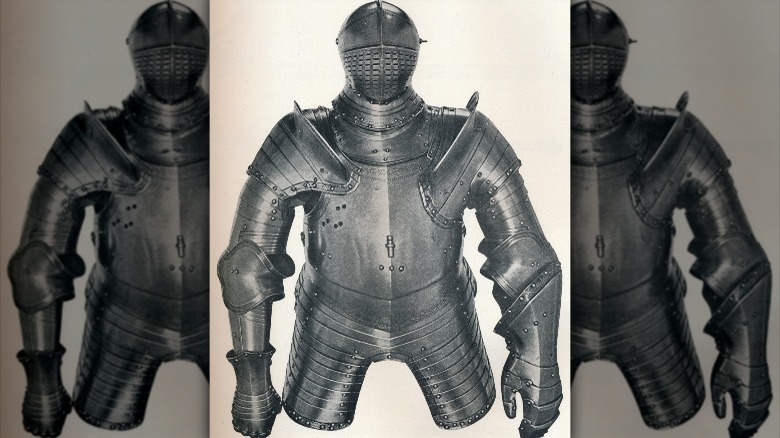Queen Elizabeth Owns Some Surprising Things
Since her ascent to the throne in 1952, Queen Elizabeth II has built a reputation in her more than 70 years on the throne as a dutiful and dependable monarch (via the official site of the British royal family). She has been quoted as having promised the English people, "my whole life whether it be long or short shall be devoted to your service." Besides her sense of duty to English citizens, the queen also has in her possession some downright surprising things. Other than all her magnificent castles and royal grandchildren, what stuff can the queen of England actually call her own?
From the oldest living queen award to all the dolphins in her reach, Queen Elizabeth II is a genuinely notable monarch. Here are some of the most interesting and surprising things owned by the queen of England.
All the Dolphins
Bringing a whole new meaning to "everything the light touches," Queen Elizabeth owns every single dolphin in her realm. For Queen Elizabeth superfans this is no new tidbit, and, perhaps more interestingly, the queen doesn't just own all the dolphins. Thanks to a piece of legislation from the Dark Ages, she technically owns every dolphin, whale, or sturgeon within any waters inside her realm.
Can a piece of legislation that is hundreds of years old dictate who owns whales today? According to TIME, yes, yes it can. The Treatise on the Fishery Laws of the United Kingdom is still in effect, nearly 700 years since its creation. In 1324, King Edward II of England signed the treatise into law, but its wording is a little outdated. For example, a custom before the official edict had the king and queen dividing parts of the whales, even though they both owned them. Nevertheless, Queen Elizabeth can, if she so desires, create a fleet of whales, dolphins, sturgeons, and really any other unnamed big aquatic animal to do with as she pleases.
Whether or not the queen enforces such legislation is a question for Her Majesty herself. For a monarch who has conferred with prime ministers, presidents, other royals, and more, it is hardly expected that she may be preoccupied with porpoises. Whether or not the "royal fishes" consent to such ownership is another issue entirely.
200 Launer Bags
Queen Elizabeth has a soft spot for clutches and bags, especially English-made pieces. The classic brand Launer has been making artfully crafted leather bags in England since the 1940s and supplying the queen with her personal collection since 1968 (via Royal Central). Now, she owns more than 200 Launer bags, according to royal expert Phil Dampier (and author of "What's in the Queen's Handbag? And Other Royal Secrets"), speaking with The Cut. She loves the brand so much, she awarded it a Royal Warrant in 1981 as "Manufacturer of Handbags and Leather Goods."
The bags are sold to the general public at Fortnum & Mason, with a price tag worthy of a queen's ransom – most are worth well over $2000. Nevertheless, Queen Elizabeth orders four new Launer bags a year (via Royal Central).
As far as what the queen carries in her purse, Dampier details the frequent possessions kept in one of her famous bags, including a makeup case made for her by Prince Philip, pictures of her family, and mints in case she needs them.
Queen Elizabeth also has a secret purse language she uses to communicate with her security guards. Royal Central reports that she often uses small signals with her bags to tell her staff she is ready to leave a situation. She even places her bag on a table or desk as a five-minute warning.
A Wind Dial
The King's Gallery, built for King William III, at Kensington Palace is a magnificent room with red painted walls, marble detailing, and hand-painted depictions of Ulysseus' epic tale positioned on the ceiling. All of this belongs to Queen Elizabeth II, as per Historic Royal Palaces. But one piece, in particular, stands out amongst the rest as a very important piece of history. It's a weathervane and map, positioned just above the beautiful marble fireplace.
King William III, who reigned from 1689-1702 (via Britannica), used The King's Gallery as a secret headquarters of sorts, planning military actions and strategies in the very room. What does all this have to do with a wind dial? Well, the gold-plated, wind dial and map allowed the king to tell the direction of the weather without even leaving the room, according to the documentary "Secrets of the Royal Palaces." King William III used this wind dial to tell which direction on his map of Europe the wind was blowing, allowing him to perfectly time his attacks on France, with whom England was at war with at the time, without ever leaving the room.
Two Birthdays
British monarchs have since the mid-1700s celebrated two birthdays a year, one for the public and one for the home, according to CNN. Queen Elizabeth's actual birthday falls on April 21, but she reserves this day to celebrate with her close friends and family, reports the BBC. According to CNN, English monarchs such as Queen Elizabeth have since the 1740s held public birthday celebrations in the summer to ensure good weather. All about tradition, the queen upholds this one in spite of having a spring birthday.
In 1760, King George III officialized the Trooping the Colour parade as the royal birthday parade, and it has remained so ever since. This parade takes place in June each year and is usually accompanied by gun salutes in England's great parks.
And what about the private birthday celebration? Not much is known about how Queen Elizabeth spends her private birthdays, but she does spend each one with family, with the exception of 2020, which was spent on video calls with family members instead of in person due to the COVID pandemic.
A Fleet of Expensive Cars and Carriages
Although it may shock some, Queen Elizabeth II was an avid driver in her day, even seen driving around other members of British nobility as recently as 2016 (via Hot Cars). The queen's love of driving extends to her possessions. She has over $12 million worth of antique and crazy cool cars. The collection includes a 1965 Mercedes Benz, a 1953 Humber Super Snipe, and a 1948 Daimler DE.
The queen's interest in vehicles expands beyond the driving world. In World War II, she served as a mechanic. So, not only can England's monarch drive a car, she can repair one. Though she is more often than not chauffeured in one of her beautiful cars as opposed to driving them, the queen's collection is hardly anything to dismiss.
She also owns quite a few historic carriages. The 100-plus carriages in her possession, traditionally used for celebrations, according to the documentary "Secrets of the Royal Palaces," are reserved for public spectacle. One of the queen's most priceless carriages, the Diamond Jubilee State Coach, requires six horses to move it around. The solid black coach with golden detailing provides Queen Elizabeth II with just enough pomp while not overshadowing circumstance. The large windows allow a clear view of the monarch for citizens and tabloids alike. Let it be known, Queen Elizabeth travels in style.
Buckingham Palace
There is a convention among the English aristocrats wherein one is almost expected to have a home in the country for getting away and one in the city specifically used for entertaining and accepting guests. If Balmoral is Queen Elizabeth's "get away," so to speak, then Buckingham Palace is the queen's London hub.
According to the "Secrets of The Royal Palaces" documentary, the castle, positioned in the middle of London for all to see, is the most visited spot in all of the city. Reconstructed from an old building in the early 19th century for King George IV, Buckingham Palace has housed all English royals since its construction, and the palace is the venue for a wide variety of royal celebrations, including birthdays, milestone celebrations, concerts, meetings with other world leaders, garden parties, and more.
Buckingham Palace is famous for its large balcony on the front facade of the building. Here, the royal family stands together as a united group to be viewed by the world, and here some famous historical moments have taken place. For example, Prince George and Princess Diana waved to the public from the balcony in 1981 and became the first royal couple to kiss there in front of the whole of London. Buckingham Palace is no ordinary London home. It is a palace filled with royal history and many firsts for the royal family. Queen Elizabeth not only employs the palace as a place of celebration but as a home for herself and her loved ones, making this a special possession indeed.
A Gold Record
A monarch is expected to attend and put on countless parties, ceremonies, and balls, and Queen Elizabeth's Golden Jubilee was, perhaps, one of the largest and most talked about parties yet. The entire event was put on to celebrate the queen's having held her position for 50 years (via the official website of the British royal family). Ever generous, Queen Elizabeth spoke directly to the people during her Golden Jubilee to thank her subjects for their loyalty and support over the years.
To celebrate such a mileston, the royal family hosted a "Party at the Palace" pop concert, which BBC News called even better than Live Aid. The concert was recorded, and all 100,000 copies of the CD were sold within weeks of being released (via the official website of the British royal family). This earned Queen Elizabeth II a gold record, making her the first British royal to have been rewarded the prize.
A Colony of Bats that Lives in her Castle
Like something out of a Victor Hugo novel, a colony of bats resides inside one of the queen's oldest and most expensive castles — Balmoral. This is the same castle where Princess Diana was introduced to the family, as per the "Secrets of The Royal Palaces" documentary. Balmoral is private and secluded, which makes it the perfect place to escape the world or introduce a new member to the royal family.
Princesses and family events aside, the queen's most recent guests at Balmoral have provided her with plenty of entertainment. Adam Helliker, the royal editor, spoke to The Sun about the bats. Helliker said the bats have been there for more than 30 years, and that, in her more spritely days, the queen would wield a butterfly net and help her staff catch the little creatures, safely returning them to the outside. Helliker also told The Sun that, although she no longer runs about catching them herself, the animal-loving queen always leaves the castle windows open in case the bats return.
The Most Paintings in the World
For most of us laymen, the term "art collection" refers to the various selfies and pictures of food on our camera rolls. To the queen of England, owning art is a little more upscale. The queen holds the largest private art collection in the world, as per art collective and marketplace FineArtMultiple. How many works of art counts as "the most in the world?" Queen Elizabeth II owns 537,000 artworks including paintings, drawings, and prints, all masterfully crafted and worth their fair share of her personal fortune.
Her collection is worth well over $12 billion and includes works by some of the world's most precious masters of the arts. This includes works by Leonardo da Vinci, Giovanni Canaletto, and Rembrandt. The entirety of the Royal Art Collection belongs to the commonwealth, in the unlikely event that the monarchy is done away with.
Even a British monarch cannot grow such a collection as the queen's alone. Queen Elizabeth inherited the collection from previous rulers and is said to care more for her horses than the paintings. That said, the queen does have better things to do than stand around looking at portraits all day.
Queen Victoria's Sketchbooks and Diaries
That's right. Queen Elizabeth II owns a sketchbook. Surprised? Well, this is no ordinary sketchbook. The queen owns the very books in which her great-great-grandmother Queen Victoria used to draw, which are part of the Royal Collection, as per the Royal Collection Trust. As an article in the Journal of the Royal Society of the Arts notes, Victoria was quite a talented artist, sketching from an early age, recognizable figures in her life, including, later, her own husband, Prince Albert. She also used art as a medium to chronicle her travels and daily life.
It is not recorded how Queen Elizabeth feels about the sketchbooks, but it serves as a beautiful reminder of the past and an excellent demonstration of her grandmother's family values.
The queen also owns her grandmother's personal diaries, as per the official website of the royal family. Something as private as a diary seems like an odd family relic, but, as history has proven, the lives of royals are often more public than private. In her journals, Queen Victoria wrote about everything from her breakfast plans to waging wars, with each moment of her reign unfolding in the pages of this antique diary.
Four Guinness World Records
Queen Elizabeth has received four Guinness World Records. No, she hasn't been awarded for the most hula hoops spun or for the fastest car, but her awards are just as interesting. The queen's awards include one for being the longest reigning monarch of England (via Guinness World Records). Queen Elizabeth ascended the English throne in 1952, meaning she has been in power for 70 years as of 2022, quite the remarkable feat. She also holds the record for the oldest current monarch at the age of 96 ini 2022.
More interestingly, the queen holds the record for the wealthiest queen, with a personal fortune worth over $500 million, and the "most currencies featuring the same individual," according to the Guinness World Records website. There has been so much currency printed with her face over the years that one can view the aging process of Queen Elizabeth by looking at British money in order of print. Now, that's a photo album.
Henry VIII's Armor
Family heirlooms are the bread and butter of European aristocracy. Queen Elizabeth II's vast collection of heirlooms includes pieces of armor worn by her ancestor Henry VIII, as per the Royal Collection Trust.
Created at the Royal Armoury for Henry VIII in 1539, this particular set of armor is made of steel and once dazzled men on the jousting field with heavily decorative detailing (via Google Arts&Culture). One notable aspect of this particular suit is its rather large waistline, as by the time this armor was fashioned, Henry had gained considerable weight. The armor itself was likely made in celebration and for a bit of pageantry to commemorate his marrigae to Anne of Cleves.
